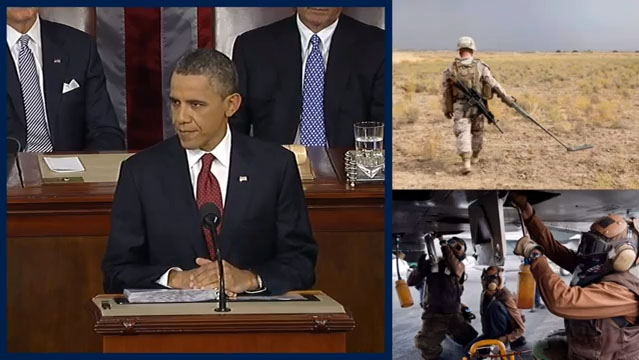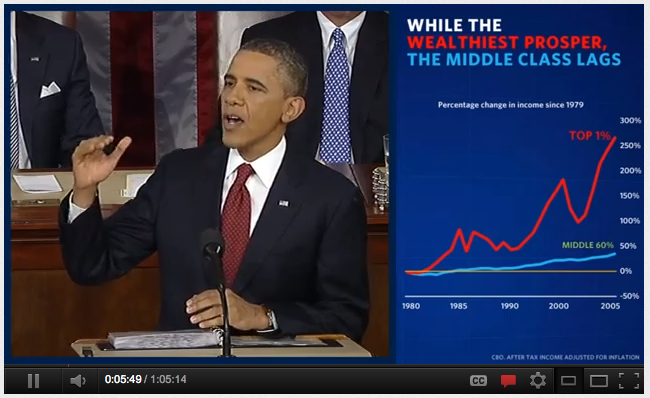On January 24th of 2012, President Barack Obama delivered the State of the Union address. For the second time, the White House made it available online with a special enhanced broadcast complementing the speech with onscreen presentation graphics.
I know what you’re thinking—a Powerpoint from the President? Who does he think he is, Ross Perot? Our founding fathers must be turning in their graves.
Or perhaps not. Article II, Section 3 of the Constitution provides that the president “shall from time to time give to the Congress Information of the State of the Union, and recommend to their Consideration such Measures as he shall judge necessary and expedient.” Since 1790, the President has delivered the address to Congress by speech and/or in writing. Media such as newspapers, radio, and television have been instrumental in communicating it to the American public. It’s even been broadcast on the web since the 90’s. So, can an enhanced webcast really be such a game-changer?
Yes—and the key is the shift in approach. Rather than using media technology to simply expand access, the Obama administration is using it to reinforce their message. Traditionally, the formula for success speeches has relied on rhetoric and oratorial skill. And while the most charismatic speakers can artfully communicate themes, concepts, and imagery—these all reside in the mind. Each member of the audience must use their imagination to interpret the concepts, and in so doing draw on their own connotations, opinions, and preconceptions to comprehend it.
The Obama Administration’s approach is different. By complementing the address with imagery, charts, diagrams and other content, the President can communicate far more information than possible in oratory alone; by showing and not just telling, he bridges a substantial comprehension gap with his audience and has the opportunity to impart upon them a deeper, more meaningful understanding. And as experienced communicators know (and research proves) adding images to a presentation can boost audience retention dramatically, by a factor of six or more according to some studies.
In what’s been the most powerfully-branded presidency in our history, the Obama administration has once again harnessed the power of design and visualization to their advantage. Here are just a few examples of how some of the slides helped—and hurt—the 2012 State of the Union:
Making it Real
To drive home his acknowledgement of the extraordinary work of U.S. troops, Obama showed a photograph of service members in action abroad. Though no modern politician has failed to mention this topic given the opportunity, showing an image refreshes its meaning. It transforms a political talking point into a specific reality that the audience can share, and can help to elicit a more emotional response.

Reinforcing Key Points
When discussing the importance of education, Obama cited a statistic about the additional earning power associated with a high school diploma. Using the tried-and-true advertising technique of repetition, Obama alludes to the issue both in his remarks and onscreen, cementing it in the mind of the audience.

Exposing Economic Realities
With more complex trends, the benefits of a visual approach can be even greater. Democrats and Republicans typically trade barbs over the economic record, cherry-picking stats and performance periods to prove their case. With this graph depicting historical CBO data on the real tax adjusted income of the top 1% of Americans vs the middle 60%, Obama proved his assertion that incomes of the rich are indeed leaving the middle class behind.

Committing Graphic Misdemeanors
Unfortunately, the enhanced address is also rife with malapropisms. A slide to introduce the Financial Crimes unit would be fine if the title font did not mimic the logotype for the popular television series, Law & Order. Here, the desire to connect with the audience on a pop culture level undermines the seriousness of the subject matter.

Committing Graphic Felonies
Elsewhere, grievances are more severe. This slide uses Pac-Man as a metaphor for navigating the job retraining and application process. While this analogy may not be without merit, it is utterly lacking in sensitivity to the struggles of millions of unemployed Americans. After all, if you lose at Pac-Man, you lose your quarter; if you lose a potential job, you could lose your home.

With the enhanced broadcast of the State of the Union address, the Obama administration has unlocked a powerful tool that may amplify the impact of his message to an unprecedented degree. Used well, it has the potential to deliver a more persuasive argument than possible by rhetoric alone. Used poorly, it can undermine the message and drive a wedge between his administration and the audience. The State of the Union is a serious moment, an opportunity for the leader of the largest economy in the world to connect with the government and its people. It demands a thoughtful presentation that is equal to the charge.




